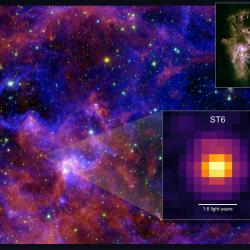UMD Astronomers Help Discover Compact Star Clusters in Distant, Infant Galaxy
Astronomy Professor Massimo Ricotti and postdoctoral associate Brian Welch co-authored this latest research, which used the James Webb Space Telescope to see how early stars are born.
With help from NASA’s James Webb Space Telescope, an international team of scientists made the first discovery of compact star clusters in an infant galaxy. Published in the journal Nature on June 24, 2024, their findings reveal the birth of five massive star clusters in the Cosmic Gems arc, a galaxy that formed less than 500 million years after the Big Bang.

Though this galaxy is nearly 13 billion light-years away from Earth, the Webb telescope was able to see it in high resolution due to a phenomenon known as gravitational lensing. When gravity bends light, it can “act as a telescope, magnifying anything behind it,” and the Cosmic Gems arc just happens to be situated behind one of these natural lenses, explained study co-author and University of Maryland Astronomy Professor Massimo Ricotti.
“These star clusters are among the farthest objects that we have discovered with Webb, so it’s an incredible magnification,” Ricotti said. “We were able to see compact star clusters that are one parsec in size, which is very small on a cosmological scale. For comparison, the distance between our sun and the center of our galaxy is about 8,000 parsecs.”
Hubble was the first space telescope to observe this distant galaxy, but Webb’s near-infrared camera enabled astronomers to study its millions of densely packed stars in minute detail.
“The surprise and astonishment was incredible when we opened the Webb images for the first time,” said the study’s lead author Angela Adamo of Stockholm University and the Oskar Klein Centre in Sweden. “We saw a little chain of bright dots, mirrored from one side to the other—these cosmic gems are star clusters! Without Webb we would not have known we were looking at star clusters in such a young galaxy.”
The research team determined that the formation of these early star clusters likely played a role in shaping the properties of galaxies during the universe’s early history. Young galaxies underwent bursts of star formation that generated substantial amounts of radiation, changing the chemical composition of the cosmos and enabling light to travel more freely in a process known as reionization.
Some astronomers—including Ricotti—have argued that these early compact star clusters could have evolved into the globular star clusters that we see today, which are similarly dense. Ricotti said his theory was previously considered unpopular, but thanks to Webb, new observations are helping to fill gaps in the universe’s history.
“This result is very exciting because the observations confirm some theoretical models I have been working on for a long time,” Ricotti said. “I have argued that compact star clusters, perhaps the progenitors of today's globular clusters, are a dominant mode of star formation in primordial galaxies and that their formation can help explain how the universe was reionized.”
Going forward, the research team plans to collect more data on the Cosmic Gems arc in hopes of understanding the physical properties of its star clusters in greater detail. And in the future, the team hopes to build a sample of galaxies for which similar resolutions can be achieved.
“I am confident there are other systems like this waiting to be uncovered in the early universe, enabling us to further our understanding of early galaxies,” said study co-author Eros Vanzella from the INAF - Astrophysics and Space Science Observatory of Bologna.
For his part, Ricotti is excited to continue taking part in an observational study—a chance he doesn’t often get as a theorist.
“I've been thinking about the formation of star clusters and their role in driving reionization for a long time,” Ricotti said. “But I think the most impressive thing about this observation is the incredible power of the James Webb Space Telescope to observe objects that are just one parsec in physical size. At that distance, it’s just mind-blowing.”
###
This article was adapted from text provided by the European Space Agency.
In addition to Ricotti, UMD astronomy postdoctoral associate Brian Welch also co-authored this study. Titled “Bound star clusters observed in a lensed galaxy 460 Myr after the Big Bang,” their paper was published in Nature on June 24, 2024.
This research was supported by NASA (Award Nos. NAS5-03127 and NAS5-03127), the Swedish research council Vetenskapsradet (Award Nos. 2021-05559 and 2022-03804), Spain’s Ministry of Science, the United States-Israel Binational Science Foundation (Grant No. 2020750), the U.S. National Science Foundation (Grant No. 2109066), Israel’s Ministry of Science & Technology, the Israel Science Foundation (Grant No. 864/23), the European Union's Horizon 2020 research and innovation program (Grant No. 898633), the MSCA IF Extensions Program of the Spanish National Research Council, the State Agency for Research of the Spanish MCIU, MCIN/AEI (Grant No. CEX2021-001131-S), JSPS KAKENHI (Grant Nos. JP22H01260, JP20H05856, JP22K21349, JP23H00131, 22H01258, 22H04939 and 23K20035), PRIN-MIUR (Grant No. 2020SKSTHZ), INAF, the Leading Initiative for Excellent Young Researchers, MEXT and Japan (Award No. HJH02007). This article does not necessarily reflect the views of these organizations.







